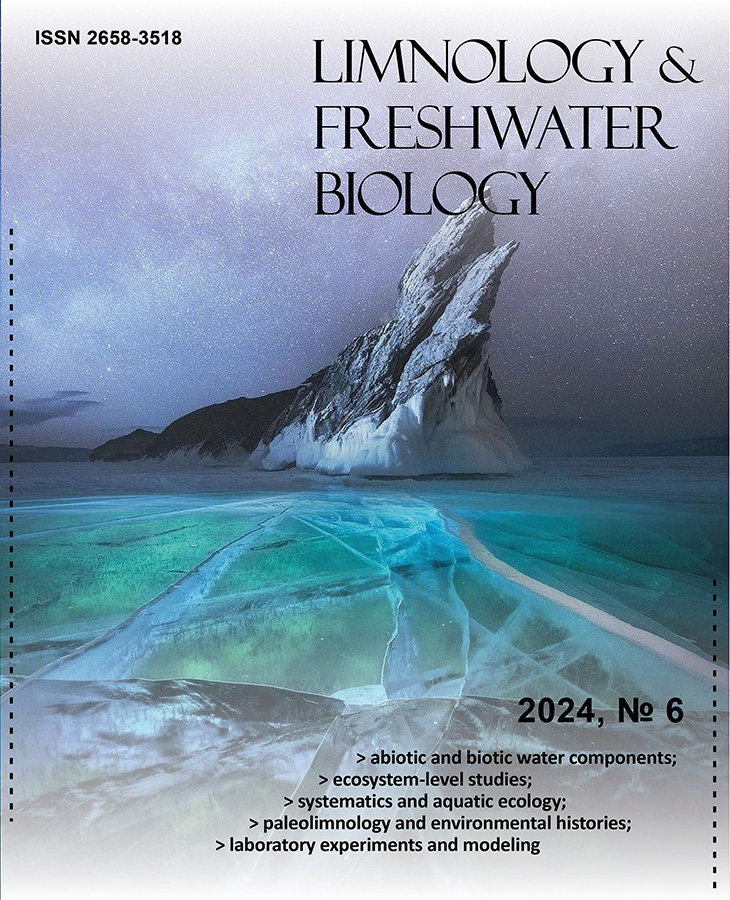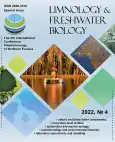Study of Holocene aeolian morpholithogenesis of the Eastern coast of the White Sea using georadiolocation and palaeolimnological methods
- Authors: Repkina T.Y.1,2, Leontiev P.A.2, Kublitskiy Y.A.2, Krekhov A.K.3, Gurinov A.L.1,4, Vyatkin E.D.2, Orlov A.V.2, Lugovoy N.N.1,5
-
Affiliations:
- Institute of Geography, Russian Academy of Sciences
- Herzen State Pedagogical University of Russia
- St. Petersburg State University
- Russian Friendship University of Russia
- Lomonosov Moscow State University
- Issue: No 4 (2022)
- Pages: 1541-1543
- Section: Articles
- URL: https://journal-vniispk.ru/2658-3518/article/view/289207
- DOI: https://doi.org/10.31951/2658-3518-2022-A-4-1541
- ID: 289207
Cite item
Full Text
Abstract
Holocene aeolian topography and sediments were investigated at two key sites on the Zimny Coast and one key site on the Kaninsky Coast of the White Sea. Field work included ground penetration radar profiling, paleolimnological and geomorphological study, as well as aerial imagery and topography surveys. Analytical studies including grain-size, geochemical and diatom analyses and radiocarbon dating of lake sediment cores were performed. Accumulative aeolian relief was formed in areas with a positive coastal-marine sediment balance. The sands are brought in by a longshore drift or river discharge. The aeolian topography and the number of stages of aeolian activation vary across the key areas. The present-time coastal dunes have been forming since the late or middle Holocene, when relative sea level became close to contemporary levels.
Full Text
1. Introduction
Aeolian processes are among of the most important components of coastline morpholithogenesis of the World’s Oceans (Vyhovanets, 2003; Sloss et al., 2012). The shape and dynamics of coastal aeolian relief depend on a complex combination of factors. The most important of these are the sediment balance in the coastal zone, the direction of the prevailing winds relative to the coastal line and the changing configuration of coasts. The activation rhythms of coastal aeolian processes depend on the relative sea level (RSL) and the regime of winds, waves and fast ice changes. Despite a long period of study of coastal dunes and foredunes, including on the Arctic shores (Ruz and Hesp, 2014), the response of coastal aeolian processes to changes in the natural environment remains a subject of debate (Badyukova and Solovieva, 2015). On the shores of the White Sea, this problem had hardly been studied. Our studies are aimed at obtaining actual data on the aeolian relief and rhythms of activation of aeolian processes on the Eastern coast of the White Sea after deglaciation.
The largest areas of Holocene aeolian landform development are located in the sites of coastal accumulation. These are estuaries or areas of divergence coastal sediment flows. The first data on the aeolian topography and deposits have been obtained at the three key sites - from Intsy to the mouth of the Ruch’i River and in the region of the mouth of the Maida River (Zimniy Coast) as well as at the mouth of the Shoina River (Kaninsky Coast).
2. Materials and methods
The research methodology involves the geophysical (GPR), paleolimnological, geodesic (UAV and DGPS surveys), geomorphological, analytical (geochemical, micropaleontological) and geochronological (radiocarbon and OSL dating) methods. This allows for a comparative analysis of the modern and relict coastal aeolian landforms and sediments with the lithological and stratigraphic sequence of bottom sediments of coastal lakes or peat bogs, located in the zone of aeolian transport.
GPR profiling is carried out using Zond-12e GPRs and OKO (antennas with frequencies ranging from 50 to 400 MHz). This allows the characteristics of the sediment sections to be obtained to a depth of up to 20 m. Radarograms are processed in Prism 2.5-2.7 software, RadExplorer 1.42 and GeoScan32. Interpretation of radarograms is based on wave pattern analysis according to the methodology (Starovoitov, 2008) taking into account coring data.
Geodesic profiling is carried out using DGPS PrinCe i50, aerial photography quadcopters DJI Phantom 4 Pro v2.0. and DJI Mini2. As a result, orthophoto images and digital elevation models were produced. These are used for altitude referencing of GPR profiles, calculation of aeolian volumes and production of terrain morphodynamics maps.
Geomorphological studies include interpretation of multi-temporal satellite and aerial images, profiling of coastal terraces, and analysis of the landforms and dynamics of the modern coastal zone.
Coring of lake and peat bogs deposits is performed using a Russian peat corer (sampler diameter - 5 cm, length - 100 cm). The sediments sampling was performed from the ice in spring and from a platform in summer.
The coring is accompanied by lithological and stratigraphic description of cores according to the methodology (Subetto, 2009) and core sampling for analytical studies. Cores were taken in 1 m long plastic halfpipes. Analytical studies and dating of lake-bogs sediments provided information on RSL changes and rhythms of aeolian process activation.
3. Results
In the area from Intsy Cape to the mouth of the Ruch’i River (Zimniy Coast) the Holocene coastal dunes were formed in three sites.
On the right bank of the Ruch’i River, dunes were ~2 km long, ~0.3 km wide and 4 m high. The dunes overlapped the sand spit and slopes of moraine ridges. Two aeolian sand horizons on the GPR profiles were identified. Their thickness increases from the root to the distal end of the spit. However, in the sediments of the paleolagoon the aeolian sand are distributed evenly.
In the northern part of the Intsy accumulative cape, dunes were located to the inner edge of the Holocene marine terrace. The dunes were ~5.5 km long, 0.2-0.5 km wide and relative height up to 10 m. GPR profiles here also show two horizons of aeolian sands. Their thickness increases in the area where sediments fall out of the longshore drift (Lugovoy and Repkina, 2019).
To the south of Cape Intsy, dunes were developed in the paleostrait between moraine ridges. The paleostrait is filled with sediment from two small rivers. Dunes were 0.1-0.5 km long, up to 50 m wide and up to 2 m relative height. They move in the direction of the prevailing winds - from the rivers towards the the sea coast.
At the mouth of the Maida River (Zimniy Coast) dunes (~3 km long and up to ~1.5 km wide) were developed on the sand spit. The height of the foredunes rises from 1-2 m at the root of the spit to 4-5 m at its distal. Further out from the sea, four dune ridges (5-18 m height), were traced parallel or at an angle to the modern coastline. The internal structure of eolian sands on GPR profiles becomes more complex with distance from the sea coast. Thin layers enriched with aeolian sand were found in the peat deposits of the swampy palaeolagoon.
On the mouth-spit of the left bank of the Shoina River (Kaninsky Coast) dunefields ~8 km long, up to ~0.6 km wide and up to 22 m in relative height are developed. They consist of four dune ridges, parallel to the coastline of the sea. In their turn the ridges consist of individual dunes, which run almost perpendicular to the seashore and parallel to the river bank. GPR profiles show the complex internal structure of the dunes. The number of aeolian sand horizons increases with distance from the seashore and river mouth.
4. Discussion
The age of the dunes has not yet been determined. It can be assumed that they began to develop on the Zimny Coast simultaneously with low marine terraces - after ~4.7-4.3 ka BP (Repkina et al., 2019; Shilova et al., 2019) and are still being formed. Large horizons of aeolian sands, which we see on GPR profiles, probably correspond to the stages of intensification of aeolian processes. The age of these horizons can be most easily determined by dating the sand-enriched paleolagoon sediments.
5. Conclusions
In the key areas studied, the coastal dunes were formed by sediments that come from two main sources. In the areas of river mouths of the rivers Ruch’i, Maida and Shoina, and also on Cape Intsy, the main source of sand is the longshore drift. Whereas in the paleostrait south of Cape Intsy, the main source of sand is river. The internal structure of dunes and the number of stages of aeolian activation are different at the key sites. The present coastal dunes have been formed since the Late or probably since the Middle Holocene, when the RSL became close to the contemporary level.
Acknowledgements
The research was supported by the Russian Science Foundation project No. 22-27-00499 (field geomorphological and GPR research at the mouth of the Maida and Shoina rivers), under the financial support of the Russian Ministry of Education (project No. FSZN-2020-0016) - paleolimnological research, the state assignment № FMGE-2019-0005 of the IG RAS (geomorphological interpretation), the State Program 121040100323-5 (UAV survey, DGPS), supported by RUDN University Strategic Academic Leadership Program (GPR research of Intsy-Ruch’i site).
Conflict of interest
There is no potential conflict of interest.
About the authors
T. Y. Repkina
Institute of Geography, Russian Academy of Sciences; Herzen State Pedagogical University of Russia
Author for correspondence.
Email: t-repkina@yandex.ru
Russian Federation, 29 Staromonetnyy lane, Moscow, 119017; 48 Naberezhnaya reki Moyki, St. Petersburg, 191186
P. A. Leontiev
Herzen State Pedagogical University of Russia
Email: t-repkina@yandex.ru
Russian Federation, 48 Naberezhnaya reki Moyki, St. Petersburg, 191186
Yu. A. Kublitskiy
Herzen State Pedagogical University of Russia
Email: t-repkina@yandex.ru
Russian Federation, 48 Naberezhnaya reki Moyki, St. Petersburg, 191186
A. K. Krekhov
St. Petersburg State University
Email: t-repkina@yandex.ru
Russian Federation, 7-9 Universitetskaya Naberezhnaya, St. Petersburg, 199034
A. L. Gurinov
Institute of Geography, Russian Academy of Sciences; Russian Friendship University of Russia
Email: t-repkina@yandex.ru
Department of Landscape Design and Sustainable Ecosystems, Agrarian-Technological Institute, Russian Friendship University of Russia
Russian Federation, 29 Staromonetnyy lane, Moscow, 119017; 6 Miklukho- Maklaya Str., Moscow, 117198E. D. Vyatkin
Herzen State Pedagogical University of Russia
Email: t-repkina@yandex.ru
Russian Federation, 48 Naberezhnaya reki Moyki, St. Petersburg, 191186
A. V. Orlov
Herzen State Pedagogical University of Russia
Email: t-repkina@yandex.ru
Russian Federation, 48 Naberezhnaya reki Moyki, St. Petersburg, 191186
N. N. Lugovoy
Institute of Geography, Russian Academy of Sciences; Lomonosov Moscow State University
Email: t-repkina@yandex.ru
Faculty of Geography of Lomonosov Moscow State University
Russian Federation, 29 Staromonetnyy lane, Moscow, 119017; 1 Leninskie Gory, Moscow, 119991References
- Badyukova E.N., Solovieva G.D. 2015. Coastal aeolian forms and sea level fluctuations. Okeanologiya [Oceanology] 55(1): 139-139. (in Russian)
- Lugovoy N.N., Repkina T.Yu. 2019. Coastal dynamics of the accumulative Intsy Cape (Zimniy Coast of the White Sea). In: International Conference “INQUA 2019”, p. 2134.
- Repkina T.Yu., Zaretskaya N.E., Shilova O.S. et al. 2019. Southeastern coast of the White Sea Gorlo straight in the Holocene: relief, deposits, dynamics. In: Annual Conference on the Results of Expedition Research “Rel’ef i chetvertichnye obrazovanija Arktiki, Subarktiki i Severo-Zapada Rossii. Vyp. 6.”, pp. 146-153. doi: 10.24411/2687-1092-2019-10621 (in Russian)
- Ruz M.-H., Hesp P.A. 2014. Geomorphology of high-latitude coastal dunes: a review. Geological Society, London, Special Publications 388: 199-212. doi: 10.1144/SP388.17
- Shilova O.S., Zaretskaya N.E., Repkina T.Yu. 2019. Holocene deposits of the south-east coast of Gorlo strait (White Sea): new data of diatom and radiocarbon analyses. Doklady Earth Sciences 488(6): 1259-1263. doi: 10.31857/S0869-56524886661-666
- Sloss C.R., Shepherd M., Hesp P. 2012. Coastal dunes: geomorphology. Nature Education Knowledge 3(10): 2. URL: https://www.nature.com/scitable/knowledge/library/coastal-dunes-geomorphology-25822000/ (last accessed: August 15, 2022)
- Starovoitov A.V. 2008. Interpretatsiya georadiolokatsionnykh dannykh. Training Manual [Interpretation of georadar data. Training manual]. Moscow: Moscow State University. (in Russian)
- Subetto D.A. 2009. Donnyye otlozheniya ozer: paleolimnologicheskiye rekonstruktsii [Bottom sediments of lakes: paleolimnological reconstructions]. St. Petersburg: RGPU im. A.I. Gertsena. (in Russian)
- Vyhovanets G.V. 2003. Eolovyy morfogenez na morskom beregu [Aeolian morphogenesis on the seashore]. Odessa: Astroprint. (in Russian)
Supplementary files










